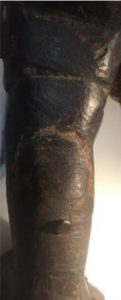August ’19
Sierra Leone Figure
August’s Object of the Month is a wooden statue from Sierra Leone and forms part of the Anthropology teaching collection at Durham University.

The figure belongs to a typology of wooden, black stained female figures that are associated with medicine and female secret societies throughout Sierra Leone and the surrounding region.

The typology of carvings that the figure belongs to are generally referred to as ‘Minsereh’ or ‘Minsere’ figures. The terms are used to describe the black-stained, standing female medicine figures from the Mende Sande society or Sherbro Yase society. However, there is contention over the use of ‘Minsereh’ as the root of the term comes the Sherbro min se le, which means ‘the spirits’. Strictly speaking there is no rational for restricting the term to the description of female figure or for its application outside of Sherbro societies. However, academics and museum professionals have canonized the use of the term to describe black-stained, female medicine figures, the vast majority being attributed to the Mende peoples.

The figure’s clothing may be evidence to its role in Sande initiation rituals. The combination of the figure’s ‘shorts’ and ‘crossed braces’ bear a striking resemblance to the attire worn by initiates when they emerge after the first period of seclusion.

Beaded necklaces and aprons are worn to indicate completed initiation; it is plausible that this type of attire was the intent of the artist. The two raised areas around the waist of the figure could represent waist talismans made from string and beads, rather than the top of shorts.
The scarification marks on the figure’s cheeks are also indicative of Sande initiation rituals. Decorative scarification is an indicator of completed initiation. The presence of three vertical marks on each cheek suggests the figure originates from the Sherbro or western Mende regions as this scarification pattern was common in those regions during the early 20th century.
Conservation

The wooden figure was initially surface cleaned using a vacuum and a dry brush in order to remove the loose surface dust and dirt. As there was evidence of more ingrained dirt on the wooden statue, further dry cleaning methods were tested. A conservation grade material known as akapad was used for the overall surface and an alternative conservation grade material, known as groomstick, was used on the more hard to reach areas, such as the crevices.

It was evident from visual examination that there had been a number of past repairs to the wooden figure and so these areas were tested to determine whether they were still stable and could remain in place or whether they would need to be taken down. As the previous repairs didn’t appear to be unstable they were left in place but the adhesive overspill was carefully removed using mechanical means.

Adhesive repairs weren’t the only evidence of previous treatments, as a nail and an iron rod had been used to hold several detached sections of the wooden figure together. The nail and rod were relative stable and didn’t appear to be actively corroding, however they were coated using an acrylic copolymer consolidant in order to protect them from future deterioration.

The areas of surface material loss on the wooden figure were consolidated using an appropriate material in order to stabilise the friable areas and to create a barrier between the original material and the fill material that would be added to minimise the obtrusiveness of the losses. Liberon pigmented wax was used as both a fill material and to colour match the areas of loss in order to help them blend with the original material. The wax was applied to each area of loss as a single piece and then shaped using mechanical tools in order to blend with the original surface of the wooden statue. This treatment was chosen as it was easily reversible using mechanical methods and was more controllable than using pigment or stain.

Rather than creating a replica foot to replace the missing one, a bespoke mount was constructed instead in order to stabilize the wooden figure and allow it to be displayed. A Perspex sheet was acquired and a brass rod was inserted into a hole made in the Perspex so it would sit vertically. A second brass rod was moulded to shape so it would sit around and ’hug’ the wooden figure; this would allow the statue to stand securely; this was attached to the vertical rod. This moulded section of brass rod was then covered in plastazoate in order to act as a cushion between the metal and the wooden figure to protect it from damage.
Stay tuned for next month’s object!
